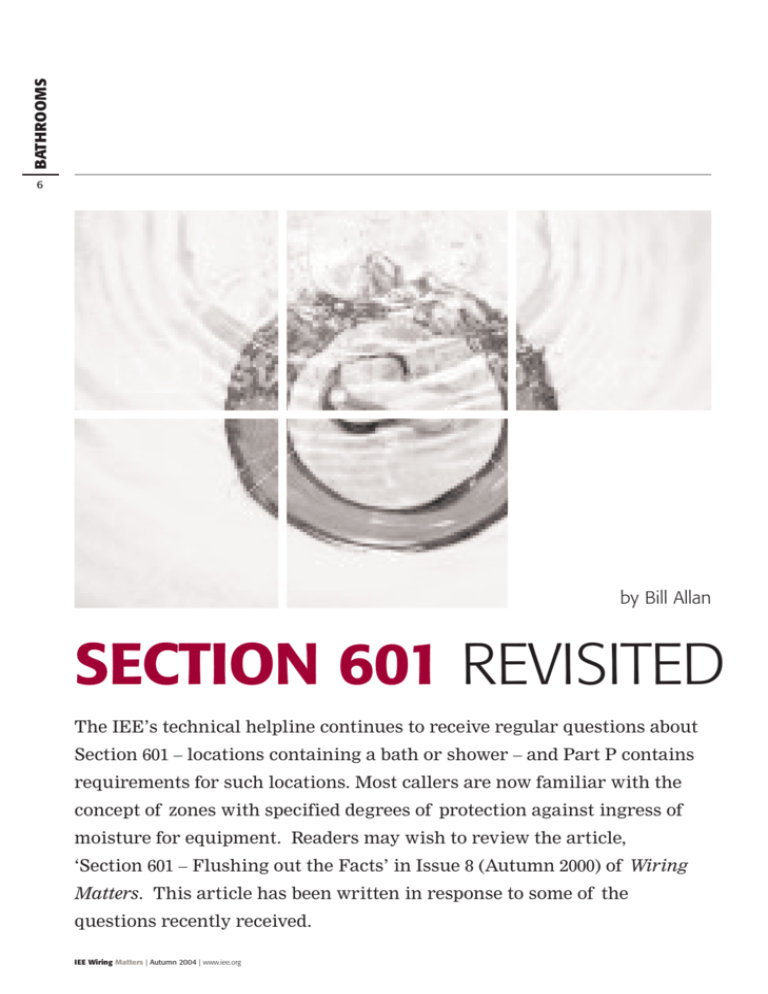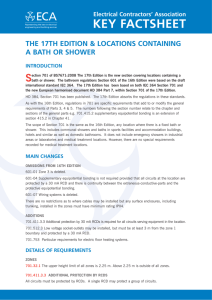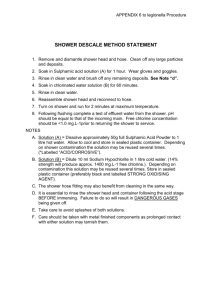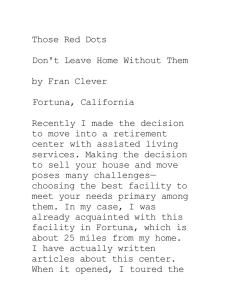
BATHROOMS
6
by Bill Allan
SECTION 601 REVISITED
The IEE’s technical helpline continues to receive regular questions about
Section 601 – locations containing a bath or shower – and Part P contains
requirements for such locations. Most callers are now familiar with the
concept of zones with specified degrees of protection against ingress of
moisture for equipment. Readers may wish to review the article,
‘Section 601 – Flushing out the Facts’ in Issue 8 (Autumn 2000) of Wiring
Matters. This article has been written in response to some of the
questions recently received.
IEE Wiring Matters | Autumn 2004 | www.iee.org
BATHROOMS
7
ELECTRICAL EQUIPMENT
The term ‘fixed current-using equipment’ is used a
number of times in Section 601 and some are unclear
as to what is meant by it. Before answering, permit me
to ask a further couple of questions. What is meant by
the expression in Regulation 601-09-03, ‘current-using
equipment other than fixed current-using equipment’?
(It may be helpful to call this type of equipment nonfixed current-using equipment). Further, the term
‘current-using equipment’ implies that there is also
non-current-using equipment.
In summarising these terms, we should be aware that
the term ‘Electrical equipment’ is defined in Part 2 of
BS 7671 and includes accessories, appliances and
luminaires.
1. Fixed current-using equipment
Current-using equipment is equipment which
consumes current rather than simply transmitting or
switching current. This would include luminaires and
fans, for example.
2. Fixed non current-using equipment
This includes switches and fused connection units.
3. Non-fixed current-using equipment
The expression ‘current-using equipment other than
fixed current-using equipment’ used in Regulation 60109-03 (or non-fixed current-using equipment) refers to
items of stationary equipment. Stationary equipment is
defined as equipment having a mass exceeding 18kg and
not provided with a carrying handle. This would include
such items as washing machines and tumble dryers.
Before anyone asks, we’ll assume that, in the context
of Section 601, there is no such thing as non-fixed non
current-using equipment!
equipment when it is permanently connected to the
supply via a fused connection unit? The answer is
generally no, but a problem arises with hand-held
equipment. The situation with hair dryers illustrates
the point. It is generally recommended that the pistol
grip type of hair dryer should be avoided within the
zones, but the flexible hose type can be connected
within zone 3 when supplied from a fused connection
unit protected by a 30mA RCD.
BEYOND ZONE 3
For the larger bathroom and shower room with space
beyond zone 3, portable equipment is not excluded by
Section 601. This means that hair dryers may be installed
– even the pistol grip variety – but, while Section 601 does
not require them to be protected by a 30 mA RCD, it may
be advisable to supply them using a fused connection
unit protected by a 30mA RCD.
SHAVER SUPPLY UNITS
The minimum degree of protection for equipment
installed in zones 1 and 2 is IP4X or IP5X where water
jets are likely to be used for cleaning purposes in
communal baths or communal showers. An exception
to this requirement is a shaver supply unit complying
with BS EN 60742 Chapter 2, Section 1, which, although
it does not meet the requirements of IP4X, is permitted
in zone 2 but must be located where direct spray from
showers is unlikely. This type of shaver supply unit,
which incorporates a safety isolating transformer, is the
only type which is permitted in a bathroom or shower
room. However, where a shower cubicle is installed in a
room other than a bathroom or shower room, e.g. in a
bedroom, this particular type of shaver supply unit is
not insisted upon. (See Regulation 601-08-02)
WHAT IS PERMITTED IN ZONE 3
There are no particular ingress protection
requirements for zone 3. This means that BS 1363
accessories, such as switches and fused connection
units, can be installed in zone 3, subject to the
requirements of Regulation 512-06-01.
Non-fixed current-using equipment, such as washing
machines and tumble dryers for example, may be
installed in zone 3, subject to manufacturers’ approval.
Such equipment must be supplied by means of a fused
connection unit and be protected by a 30mA RCD.
HAIR DRYERS
Portable equipment is not permitted in zone 3, other
than that associated with SELV socket outlets and
shaver supply units. However, the question arises: is an
item of portable equipment still an item of portable
IEE Wiring Matters | Autumn 2004 | www.iee.org
BATHROOMS
8
RCDS
Residual current devices (RCDs) having a rated
residual operating current I=n not exceeding 30mA are
required in the following situations:
■ the supply circuit of fixed current-using equipment
(other than water heaters or shower pumps) which
can reasonably only be located in zone 1;
■ the supply circuit of current-using equipment other
than fixed current-using equipment in zone 3;
■ The circuit supplying 230V BS 1363 socket outlets in a
room other than a bathroom or shower room. (It should
be noted that the zonal protection system applies to such
rooms and the socket outlets must be located outside the
zones).
Section 601 does not require RCDs in circuits
supplying electric showers.
‘IN A ROOM OTHER THAN A
BATHROOM OR SHOWER ROOM’
Regulation 601-08-02 permits the installation of 230V BS
1363 socket outlets ‘Where a shower cubicle is installed in
a room other than a bathroom or shower room’. Such
socket outlets must be installed outside zones 0, 1, 2 or 3
and be protected by a 30mA RCD. However, no such
relaxation is made for baths located in rooms other than
bathrooms. It is not uncommon these days to have a bath
installed in a bedroom or even in a lounge. Such a room
effectively becomes a bathroom and is subject to the
requirements of Section 601. For example, 230V BS 1363
socket outlets would not be permitted.
SUPPLEMENTARY EQUIPOTENTIAL BONDING
Local supplementary equipotential bonding, complying
with Regulation 547-03, is required between the terminals
of circuits supplying Class 1 and Class 2 equipment in
Zones 1, 2 and 3 and all extraneous-conductive-parts in
these zones.
USING CPCS AND EXTRANEOUS-CONDUCTIVE-PARTS AS
SUPPLEMENTARY BONDING CONDUCTORS
Circuit protective conductors (CPCs), such as that
between a luminaire and its switch, for example, may
be utilised as a bonding conductor. Therefore the
supplementary bonding conductor may be connected
either at the switch or at the luminaire. Similarly with
shower circuits, the supplementary bonding conductor
may be connected either at the shower switch or at the
shower itself.
Regulation 543-02-02 (vii) permits extraneousconductive-parts, where they comply with Regulation 54302-06, to be used as supplementary bonding conductors.
WHERE IT IS NOT NECESSARY
TO SUPPLEMENTARY BOND
It is not necessary to supplementary bond items of
metalwork which are supplied by plastic pipes, as such
metalwork is unlikely to come within the definition of
an extraneous-conductive-part. Neither is it necessary
to supplementary bond short lengths of copper pipes
which are sometimes installed for aesthetic reasons in
an otherwise plastic system.
In a room other than a bathroom or shower room,
supplementary bonding is not required in zone 3.
WHERE SUPPLEMENTARY BONDING IS CARRIED OUT
Supplementary bonding does not have to be carried out
within the bathroom or shower room itself, it can be
provided at a convenient location in close proximity.
This may be in an adjacent airing cupboard, or within
the ceiling space or under the floor boards.
CONCLUSION
No doubt there are other questions which could be
dealt with regarding Section 601, but they will have to
wait until another time. ■
Published by IEE Publishing & Information Services Michael Faraday House, Six Hills Way, Stevenage, Herts, SG1 2AY, United Kingdom
Tel: +44 (0)1438 313311 Fax: +44 (0)1438 313465
Sales and Project Coordinator K Hunton Tel: +44 (0)1438 767224 Email: khunton@iee.org.uk | Editor: G D Cronshaw
Tel: +44 (0)1438 767384 Email: gcronshaw@iee.org.uk | Contributing Editors: P R L Cook, P E Donnachie, W R Allan
IEE Wiring Matters is a quarterly publication from the Institution of Electrical Engineers (IEE).
The IEE is not as a body responsible for the opinions expressed.
©2004: The Institution of Electrical Engineers. All rights reserved. No part of this publication may be reproduced, stored in a retrieval
system, or transmitted in any form or by any means without the permission in writing of the publisher. Copying of articles is not permitted
except for personal and internal use. Multiple copying of the content of this publication without permission is always illegal.
Web-offset printing by Wyndeham Heron, The Bentall Complex, Colchester Road, Heybridge, Maldon, Essex, UK
Co-operating Organisations The Institution of Electrical Engineers acknowledges the contribution made by the following
organisations in the preparation of this publication.
| British Electrotechnical & Allied Manufacturers Association Ltd – R Lewington, P D Galbraith, M H Mullins | Office of the Deputy Prime
Minister – K Bromley, I Drummond | Electrical Contractors Association – D Locke, S Burchell | City & Guilds of London Institute –
H R Lovegrove | Energy Networks Association –D J Start | Electrical Contractors Association of Scotland t/a | SELECT – D Millar, N McGuiness
| Health & Safety Executive – N Gove | National Inspection Council for Electrical Installation Contracting
IEE Wiring Matters | Autumn 2004 | www.iee.org







